An EV SRM Drive and Its Interconnected Operations Integrated into Grid, Microgrid, and Vehicle
Abstract
:1. Introduction
2. System Configuration of the Developed EV SRM Drive
3. EV SRM Drive
3.1. DC Source-Powered Fixed DC-Link Voltage SRM Drive
3.1.1. Power Circuit
- (a)
- SRM: three-phase, 12/8, 380 V, 2000 rpm, 2.2 kW.
- (b)
- Asymmetric bridge converter formed using six IGBT modules CM100DY-12H (Mitsubishi Company) (, continuous current , peak current ).
- (c)
- Dynamic brake constructed by an IGBT module CM100DY-12H and a braking resistor with
- (d)
- Dynamic load: FW and DCG are coupled to the SRM shaft to serve as its mechanical load. FW is added to increase the stored kinetic energy for the ease of performing regenerative braking.
3.1.2. Control Scheme
- (a)
- Dynamic commutation tuning scheme
- (b)
- Current control scheme
- (1)
- Back-EMF current feedforward controller (CFFC)
- (2)
- Current feedback controller
- (c)
- Speed control scheme
3.1.3. Measured Results
3.2. Battery-Powered Varied DC-link Voltage SRM Drive
3.2.1. Battery Interface DC/DC Converter
- (a)
- Discharging mode. In the motor driving operation, the DC-link voltage is established from the battery voltage in boost mode.
- (b)
- Charging mode. In the battery charging mode or regenerative braking mode, the power flow is from to . The bidirectional boost/buck converter is operated as a buck DC/DC converter.
- (a)
- Power circuit
- (1)
- Ratings: , .
- (2)
- Battery bank: nominal voltage .
- (3)
- PWM switching frequency: .
- (4)
- DC-link capacitor: .
- (5)
- Battery side capacitor: .
- (6)
- Energy storage inductors: and at 20 kHz.
- (b)
- Control scheme.
- (1)
- Current controller
- (i)
- Feedback controller
- (ii)
- Feedforward controller
- (2)
- Voltage controller
3.2.2. Battery-Powered EV SRM Drive
- ➢
- Fixed DC-link voltage: , .
- ➢
- Varied DC-link voltage: , .
4. G2V/V2G Operations
4.1. Bidirectional CLLC Resonant Converter
4.1.1. Power Circuit
- Primary side voltage: ; secondary side voltage: .
- Rated power: . The maximum charging voltage is set to 158 V and the maximum charging current is 10 A in charging mode.
- Nominal switching frequency: .
- Duty ratio: fixed in .
- Transformer turn ratio: .
- Employed ferrite core EE5525 is manufactured by A&T MAGNETICS Co., Ltd. (New Taipei City, Taiwan).
- Measured magnetizing inductance and other resonant circuit parameters: , , , , .
4.1.2. Control Scheme
- (a)
- Charging mode
- (1)
- Normal G2V charging
- (2)
- Trickle charging
- (b)
- Discharging mode
4.2. Grid-Connected Three-Phase SMR/Inverter
4.2.1. Power Circuit
- Three-phase AC line voltage: .
- DC-link voltage:
- PWM switching frequency: .
- DC-link capacitor: .
- Energy storage inductors: the three inductors are .
4.2.2. Control Scheme
- (a)
- G2V operation
- (1)
- Phase-locked loop controller
- (2)
- Current controller
- (3)
- Voltage feedback controller
- (b)
- V2G operation
4.3. Experimental Evaluation
4.3.1. G2V Operation
4.3.2. V2G Operation
5. V2V/V2M/M2V Operations
5.1. V2V Operation
5.1.1. System Configuration
- Nominal battery voltages: .
- DC-link voltage: .
- DC-link capacitor: .
- Energy storage inductors: .
- Switching frequency of interleaved boost/buck converter: .
- Nominal switching frequency of CLLC resonant converter: .
5.1.2. Measured Results
5.2. M2V/V2M Operations
5.2.1. System Configuration
- SRG (4-phase 8/6): rated speed , rated power , rated voltage .
- Power switches: IGBT modules CM100DY-12H.
- DC-link voltage: .
- BESS: nominal voltage , capacity .
5.2.2. Measured Results
- (a)
- M2V operation
- (b)
- V2M operation
- Summary: After establishing that the developed EV SRM drive has various interconnect functions, the operating characteristics of all modes are verified by a lot of measured results, which are briefly summarized as follows:
- (1)
- The battery directly powered basic EV SRM drive with is first verified, including speed dynamic response with defined specifications, the effect of DCT in enhancing the winding current response, the acceleration/deceleration, the reversible running, and the regenerative/dynamic braking operations.
- (2)
- The EV SRM drive is powered by battery via interleaved bidirectional interface converter. The fixed and varied DC-link voltages boosted from battery are used to power the motor drive, and their comparative performance is evaluated. The loss-consumed battery energies under the programed speed patterns yielded by various DC-link voltage approach are demonstrated, as shown in Figure 12 and Figure 13.
- (3)
- The G2V/V2G operations of the developed EV SRM drive are achieved by a CLLC resonant converter and a bilateral 3P3W inverter. The normal operations and satisfactory performance under G2V mode can be seen in Figure 19 and Figure 20. Regarding the V2G operation, the results presented in Figure 21, Figure 22 and Figure 23 demonstrate that the preset real and reactive powers are successfully sent back to the utility grid.
- (4)
6. Conclusions
Author Contributions
Funding
Institutional Review Board Statement
Informed Consent Statement
Data Availability Statement
Conflicts of Interest
References
- Silvas, E.; Hofman, T.; Murgovski, N.; Etman, L.F.P.; Steinbuch, M. Review of optimization strategies for system-level design in hybrid electric vehicles. IEEE Trans. Veh. Technol. 2017, 66, 57–70. [Google Scholar] [CrossRef]
- Husain, I.; Ozpineci, B.; Islam, M.S.; Gurpinar, E.; Su, G.J.; Yu, W.; Chowdhury, S.; Xue, L.; Rahman, D.; Sahu, R. Electric drive technology trends, challenges, and opportunities for future electric vehicles. Proc. IEEE Proc. 2021, 109, 1039–1059. [Google Scholar] [CrossRef]
- Ehsani, M.; Singh, K.V.; Bansal, H.O.; Mehrjardi, R.T. State of the art and trends in electric and hybrid electric vehicles. Proc. IEEE Proc. 2021, 109, 967–984. [Google Scholar] [CrossRef]
- Kato, H.; Ando, R.; Kondo, Y.; Suzuki, T.; Matsuhashi, K.; Kobayashi, S. Comparative measurements of the eco-driving effect between electric and internal combustion engine vehicles. In Proceedings of the 2013 World Electric Vehicle Symposium and Exhibition (EVS27), Barcelona, Spain, 17–20 November 2013; pp. 1–5. [Google Scholar]
- Righolt, H.C.; Rieck, F.G. Energy chain and efficiency in urban traffic for ICE and EV. In Proceedings of the 2013 World Electric Vehicle Symposium and Exhibition (EVS27), Barcelona, Spain, 17–20 November 2013; pp. 1–7. [Google Scholar]
- Athanasopoulou, L.; Bikas, H.; Stavropoulos, P. Comparative well-to-wheel emissions assessment of internal combustion engine and battery electric vehicles. Proc. Procedia CIRP 2018, 78, 25–30. [Google Scholar] [CrossRef]
- Lie, K.W.; Synnevåg, T.A.; Lamb, J.J.; Lien, K.M. The carbon footprint of electrified city buses: A case study in Trondheim, Norway. Energies 2021, 14, 770. [Google Scholar] [CrossRef]
- Rahman, K.M.; Fahimi, B.; Suresh, G.; Rajarathnam, A.V.; Ehsani, M. Advantages of switched reluctance motor applications to EV and HEV: Design and control issues. IEEE Trans. Ind. Appl. 2000, 36, 111–121. [Google Scholar] [CrossRef]
- Chiba, A.; Takano, Y.; Takeno, M.; Imakawa, T.; Hoshi, N.; Takemoto, M.; Ogasawara, S. Torque density and efficiency improvements of a switched reluctance motor without rare-earth material for hybrid vehicles. IEEE Trans. Ind. Appl. 2011, 47, 1240–1246. [Google Scholar] [CrossRef]
- Bilgin, B.; Howey, B.; Callegaro, A.D.; Liang, J.; Kordic, M.; Taylor, J.; Emadi, A. Making the case for switched reluctance motors for propulsion applications. IEEE Trans. Veh. Technol. 2020, 69, 7172–7186. [Google Scholar] [CrossRef]
- Kioskeridis, I.; Mademlis, C. A unified approach for four-quadrant optimal controlled switched reluctance machine drives with smooth transition between control operations. IEEE Trans. Power Electron. 2009, 24, 301–306. [Google Scholar] [CrossRef]
- Sikder, C.; Husain, I.; Sozer, Y. Switched reluctance generator control for optimal power generation with current regulation. IEEE Trans. Ind. Appl. 2014, 50, 307–316. [Google Scholar] [CrossRef]
- Peng, F.; Ye, J.; Emadi, A. A digital PWM current controller for switched reluctance motor drives. IEEE Trans. Power Electron. 2016, 31, 7087–7098. [Google Scholar]
- Huang, H.N.; Hu, K.W.; Wu, Y.W.; Jong, T.L.; Liaw, C.M. A current control scheme with back EMF cancellation and tracking error adapted commutation shift for switched-reluctance motor drive. IEEE Trans. Ind. Electron. 2016, 63, 7381–7392. [Google Scholar] [CrossRef]
- Mademlis, C.; Kioskeridis, I. Performance optimization in switched reluctance motor drives with online commutation angle control. IEEE Trans. Energy Convers. 2003, 18, 448–457. [Google Scholar] [CrossRef]
- Fang, G.; Scalcon, F.P.; Xiao, D.; Vieira, R.P.; Gründling, H.A.; Emadi, A. Advanced control of switched reluctance motors (SRMs): A review on current regulation, torque control and vibration suppression. IEEE Open J. Ind. Electron. Soc. 2021, 2, 280–301. [Google Scholar] [CrossRef]
- Sahu, A.K.; Emadi, A.; Bilgin, B. Noise and vibration in switched reluctance motors: A review on structural materials, vibration dampers, acoustic impedance, and noise masking methods. IEEE Access 2023, 11, 27702–27718. [Google Scholar] [CrossRef]
- Schoenen, T.; Kunter, M.S.; Hennen, M.D.; De Doncker, R.W. Advantages of a variable DC-link voltage by using a DC-DC converter in hybrid-electric vehicles. In Proceedings of the 2010 IEEE Vehicle Power and Propulsion Conference (VPPC 2010), Lille, France, 1–3 September 2010; pp. 1–5. [Google Scholar]
- Badawy, M.O.; Husain, T.; Sozer, Y.; De Abreu-Garcia, J.A. Integrated control of an IPM motor drive and a novel hybrid energy storage system for electric vehicles. IEEE Trans. Ind. Appl. 2017, 53, 5810–5819. [Google Scholar] [CrossRef]
- Zhao, N.; Schofield, N.; Yang, R.; Gu, R. Investigation of DC-link voltage and temperature variations on EV traction system design. IEEE Trans. Ind. Appl. 2017, 53, 3707–3718. [Google Scholar] [CrossRef]
- Xiao, S.; Gu, X.; Wang, Z.; Shi, T.; Xia, C. A novel variable DC-link voltage control method for PMSM driven by a quasi-Z-source inverter. IEEE Trans. Power Electron. 2020, 35, 3878–3890. [Google Scholar] [CrossRef]
- Bhaskar, M.S.; Ramachandaramurthy, V.K.; Padmanaban, S.; Blaabjerg, F.; Ionel, D.M.; Mitolo, M.; Almakhles, D. Survey of DC-DC non-isolated topologies for unidirectional power flow in fuel cell vehicles. IEEE Access 2020, 8, 178130–178166. [Google Scholar] [CrossRef]
- Alhurayyis, I.; Elkhateb, A.; Morrow, J. Isolated and nonisolated DC-to-DC converters for medium-voltage DC networks: A review. IEEE Trans. Emerg. Sel. Top. Power Electron. 2021, 9, 7486–7500. [Google Scholar] [CrossRef]
- Aranda, E.D.; Litrán, S.P.; Prieto, M.B.F. Combination of interleaved single-input multiple-output DC-DC converters. CSEE J. Power Energy Syst. 2022, 8, 132–142. [Google Scholar]
- Kim, D.H.; Kim, M.J.; Lee, B.K. An integrated battery charger with high power density and efficiency for electric vehicles. IEEE Trans. Power Electron. 2017, 32, 4553–4565. [Google Scholar] [CrossRef]
- Monteiro, V.; Ferreira, J.C.; Meléndez, A.A.N.; Couto, C.; Afonso, J.L. Experimental validation of a novel architecture based on a dual-stage converter for off-board fast battery chargers of electric vehicles. IEEE Trans. Veh. Technol. 2018, 67, 1000–1011. [Google Scholar] [CrossRef]
- Nguyen, H.V.; To, D.D.; Lee, D.C. Onboard battery chargers for plug-in electric vehicles with dual functional circuit for low-voltage battery charging and active power decoupling. IEEE Access 2018, 6, 70212–70222. [Google Scholar] [CrossRef]
- Jeong, S.; Jeong, Y.; Kwon, J.; Kwon, B. A soft-switching single-stage converter with high efficiency for a 3.3-kW on-board charger. IEEE Trans. Ind. Electron. 2019, 66, 6959–6967. [Google Scholar] [CrossRef]
- Nguyen, H.V.; Lee, D.C.; Blaabjerg, F. A novel SiC-based multifunctional onboard battery charger for plug-in electric vehicles. IEEE Trans. Power Electron. 2021, 36, 5635–5646. [Google Scholar] [CrossRef]
- Cai, J.; Zhao, X. An on-board charger integrated power converter for EV switched reluctance motor drives. IEEE Trans. Ind. Electron. 2021, 68, 3683–3692. [Google Scholar] [CrossRef]
- Yilmaz, M.; Krein, P.T. Review of battery charger topologies, charging power levels, and infrastructure for plug-in electric and hybrid vehicles. IEEE Trans. Power Electron. 2013, 28, 2151–2169. [Google Scholar] [CrossRef]
- Habib, S.; Khan, M.M.; Abbas, F.; Sang, L.; Shahid, M.U.; Tang, H. A comprehensive study of implemented international standards, technical challenges, impacts and prospects for electric vehicles. IEEE Access 2018, 6, 13866–13890. [Google Scholar] [CrossRef]
- Khalid, M.R.; Khan, I.A.; Hameed, S.; Asghar, M.S.J.; Ro, J.S. A comprehensive review on structural topologies, power levels, energy storage systems, and standards for electric vehicle charging stations and their impacts on grid. IEEE Access 2021, 9, 128069–128094. [Google Scholar] [CrossRef]
- Singh, B.; Singh, B.N.; Chandra, A.; Al-Haddad, K.; Pandey, A.; Kothari, D.P. A review of three-phase improved power quality AC-DC converters. IEEE Trans. Ind. Electron. 2004, 51, 641–660. [Google Scholar] [CrossRef]
- Kolar, J.W.; Friedli, T. The essence of three-phase PFC rectifier systems—Part I. IEEE Trans. Power Electron. 2013, 28, 176–198. [Google Scholar] [CrossRef]
- Williamson, S.S.; Rathore, A.K.; Musavi, F. Industrial electronics for electric transportation: Current state-of-the-art and future challenges. IEEE Trans. Ind. Electron. 2015, 62, 3021–3032. [Google Scholar] [CrossRef]
- Chai, J.Y.; Liaw, C.M. Robust control of switch-mode rectifier considering nonlinear behavior. IET Proc. Elect. Power Appl. 2007, 1, 316–328. [Google Scholar] [CrossRef]
- Huber, L.; Kumar, M.; Jovanović, M.M. Performance comparison of PI and P compensation in DSP-based average-current-controlled three-phase six-switch boost PFC rectifier. IEEE Trans. Power Electron. 2015, 30, 7123–7137. [Google Scholar] [CrossRef]
- Huang, R.; Xu, J.; Chen, Q.; Wang, L.; Geng, X. Independent current control with differential feedforward for three-phase boost PFC rectifier in wide AC input frequency application. IEEE Trans. Emerg. Sel. Top. Power Electron. 2022, 10, 7062–7071. [Google Scholar] [CrossRef]
- Khaligh, A.; D’Antonio, M. Global trends in high-power on-board chargers for electric vehicles. IEEE Trans. Veh. Technol. 2019, 68, 3306–3324. [Google Scholar] [CrossRef]
- Assadi, S.A.; Matsumoto, H.; Moshirvaziri, M.; Nasr, M.; Zaman, M.S.; Trescases, O. Active saturation mitigation in high-density dual-active-bridge DC–DC converter for on-board EV charger applications. IEEE Trans. Power Electron. 2020, 35, 4376–4387. [Google Scholar] [CrossRef]
- Min, J.; Ordonez, M. Bidirectional resonant CLLC charger for wide battery voltage range: Asymmetric parameters methodology. IEEE Trans. Power Electron. 2021, 36, 6662–6673. [Google Scholar] [CrossRef]
- Cao, Y.; Ngo, M.; Burgos, R.; Ismail, A.; Dong, D. Switching transition analysis and optimization for bidirectional CLLC resonant DC transformer. IEEE Trans. Power Electron. 2022, 37, 3786–3800. [Google Scholar] [CrossRef]
- Erdogan, N.; Erden, F.; Kisacikoglu, M. A fast and efficient coordinated vehicle-to-grid discharging control scheme for peak shaving in power distribution system. J. Mod. Power Syst. Clean Energy 2018, 6, 555–566. [Google Scholar] [CrossRef]
- Masrur, M.A.; Skowronska, A.G.; Hancock, J.; Kolhoff, S.W.; McGrew, D.Z.; Vandiver, J.C.; Gatherer, J. Military-based vehicle- to-grid and vehicle-to-vehicle microgrid-system architecture and implementation. IEEE Trans. Transport. Electrific. 2018, 4, 157–171. [Google Scholar] [CrossRef]
- Amamra, S.A.; Marco, J. Vehicle-to-grid aggregator to support power grid and reduce electric vehicle charging cost. IEEE Access 2019, 7, 178528–178538. [Google Scholar] [CrossRef]
- Moschella, M.; Murad, M.A.A.; Crisostomi, E.; Milano, F. Decentralized charging of plug-in electric vehicles and impact on transmission system dynamics. IEEE Trans. Smart Grid 2021, 12, 1772–1781. [Google Scholar] [CrossRef]
- Das, S.; Acharjee, P.; Bhattacharya, A. Charging scheduling of electric vehicle incorporating grid-to-vehicle and vehicle-to-grid technology considering in smart grid. IEEE Trans. Ind. Appl. 2021, 57, 1688–1702. [Google Scholar] [CrossRef]
- Mustafa, İ.; Çelik, Ö.; Lashab, A.; Bayındır, K.Ç.; Vasquez, J.C.; Guerrero, J.M. Power system integration of electric vehicles: A review on impacts and contributions to the smart grid. Appl. Sci. 2024, 14, 2246. [Google Scholar] [CrossRef]
- Ohoud, A.; Slama, S.A.B.; Zafar, B.A. A reinforcement learning approach for integrating an intelligent home energy management system with a vehicle-to-home unit. Appl. Sci. 2023, 13, 5539. [Google Scholar] [CrossRef]
- Li, Z.; Su, S.; Jin, X.; Xia, M.; Chen, Q.; Yamashita, K. Stochastic and distributed optimal energy management of active distribution network with integrated office buildings. CSEE J. Power Energy Systems 2022, 1–12. [Google Scholar] [CrossRef]
- Sousa, T.J.C.; Monteiro, V.; Fernandes, J.C.A.; Couto, C.; Meléndez, A.A.N.; Afonso, J.L. New perspectives for vehicle-to-vehicle (V2V) power transfer. In Proceedings of the ECON 2018—44th Annual Conference of the IEEE Industrial Electronics Society, Washington, DC, USA, 21–23 October 2018; pp. 5183–5188. [Google Scholar]
- Ucer, E.; Buckreus, R.; Haque, M.E.; Kisacikoglu, M.; Sozer, Y.; Harasis, S.; Guven, M.; Giubbolini, L. Analysis, design, and comparison of V2V chargers for flexible grid integration. IEEE Trans. Ind. Appl. 2021, 57, 4143–4154. [Google Scholar] [CrossRef]
- Shurrab, M.; Singh, S.; Otrok, H.; Mizouni, R.; Khadkikar, V.; Zeineldin, H. An efficient vehicle-to-vehicle (V2V) energy sharing framework. IEEE Internet Things J. 2022, 9, 5315–5328. [Google Scholar] [CrossRef]
- Liu, S.; Ni, Q.; Cao, Y.; Cui, J.; Tian, D.; Zhuang, Y. A reservation-based vehicle-to-vehicle charging service under constraint of parking duration. IEEE Syst. J. 2023, 17, 176–187. [Google Scholar] [CrossRef]
- Umesh, B.S.; Khadkikar, V.; Zeineldin, H.H.; Singh, S.; Otrok, H.; Mizouni, R. Direct electric vehicle to vehicle (V2V) power transfer using on-board drivetrain and motor windings. IEEE Trans. Ind. Electron. 2022, 69, 10765–10775. [Google Scholar]
- Shafiqurrahman, A.; Umesh, B.S.; Sayari, N.A.; Khadkikar, V. Electric vehicle-to-vehicle energy transfer using on-board converters. IEEE Trans. Transport. Electrific. 2023, 9, 1263–1272. [Google Scholar] [CrossRef]
- Hu, K.W.; Liaw, C.M. Incorporated operation control of DC microgrid and electric vehicle. IEEE Trans. Ind. Electron. 2016, 63, 202–215. [Google Scholar] [CrossRef]
- Rahman, M.S.; Hossain, M.J.; Lu, J.; Rafi, F.H.M.; Mishra, S. A vehicle-to-microgrid framework with optimization-incorporated distributed EV coordination for a commercial neighborhood. IEEE Trans. Ind. Informat. 2020, 16, 1788–1798. [Google Scholar] [CrossRef]
- Lu, M.Z.; Guo, Z.W.; Liaw, C.M. A battery/supercapacitor hybrid powered EV SRM drive and microgrid incorporated operations. IEEE Trans. Transport. Electrific. 2021, 7, 2848–2863. [Google Scholar] [CrossRef]
- Villa-Ávila, E.; Arévalo, P.; Ochoa-Correa, D.; Iñiguez-Morán, V.; Jurado, F. Innovative power smoothing technique for enhancing renewable integration in insular power systems using electric vehicle charging stations. Appl. Sci. 2024, 14, 375. [Google Scholar] [CrossRef]
- Caban, J.; Małek, A.; Šarkan, B. Strategic model for charging a fleet of electric vehicles with energy from renewable energy sources. Energies 2024, 17, 1264. [Google Scholar] [CrossRef]
- Kamboj, V.K.; Malik, O.P. Optimal unit commitment and generation scheduling of integrated power system with plug-in electric vehicles and renewable energy sources. Energies 2024, 17, 123. [Google Scholar] [CrossRef]
- Tirunagari, S.; Gu, M.; Meegahapola, L. Reaping the benefits of smart electric vehicle charging and vehicle-to-grid technologies: Regulatory, policy and technical aspects. IEEE Access 2022, 10, 114657–114672. [Google Scholar] [CrossRef]
- Acharige, S.S.G.; Haque, M.E.; Arif, M.T.; Hosseinzadeh, N.; Hasan, K.N.; Oo, A.M.T. Review of electric vehicle charging technologies, standards, architectures, and converter configurations. IEEE Access 2023, 11, 41218–41255. [Google Scholar] [CrossRef]
- Taghizad-Tavana, K.; Alizadeh, A.; Ghanbari-Ghalehjoughi, M.; Nojavan, S. A comprehensive review of electric vehicles in energy systems: Integration with renewable energy sources, charging levels, different types, and standards. Energies 2023, 16, 630. [Google Scholar] [CrossRef]
- Zhao, F.; Guo, Y.; Chen, B. A review of lithium-ion battery state of charge estimation methods based on machine learning. World Electr. Veh. J. 2024, 15, 131. [Google Scholar] [CrossRef]
- Zhang, R.; Xia, B.; Li, B.; Cao, L.; Lai, Y.; Zheng, W.; Wang, H.; Wang, W. State of the art of lithium-ion battery SOC estimation for electrical vehicles. Energies 2018, 11, 1820. [Google Scholar] [CrossRef]
- Chou, Z.C. Wind/PV Based DC Microgrid with Reconfigurable Interface Converter. Master’s Thesis, Department of Electrical Engineering, National Tsing Hua University, Hsinchu, Taiwan, 2023. [Google Scholar]
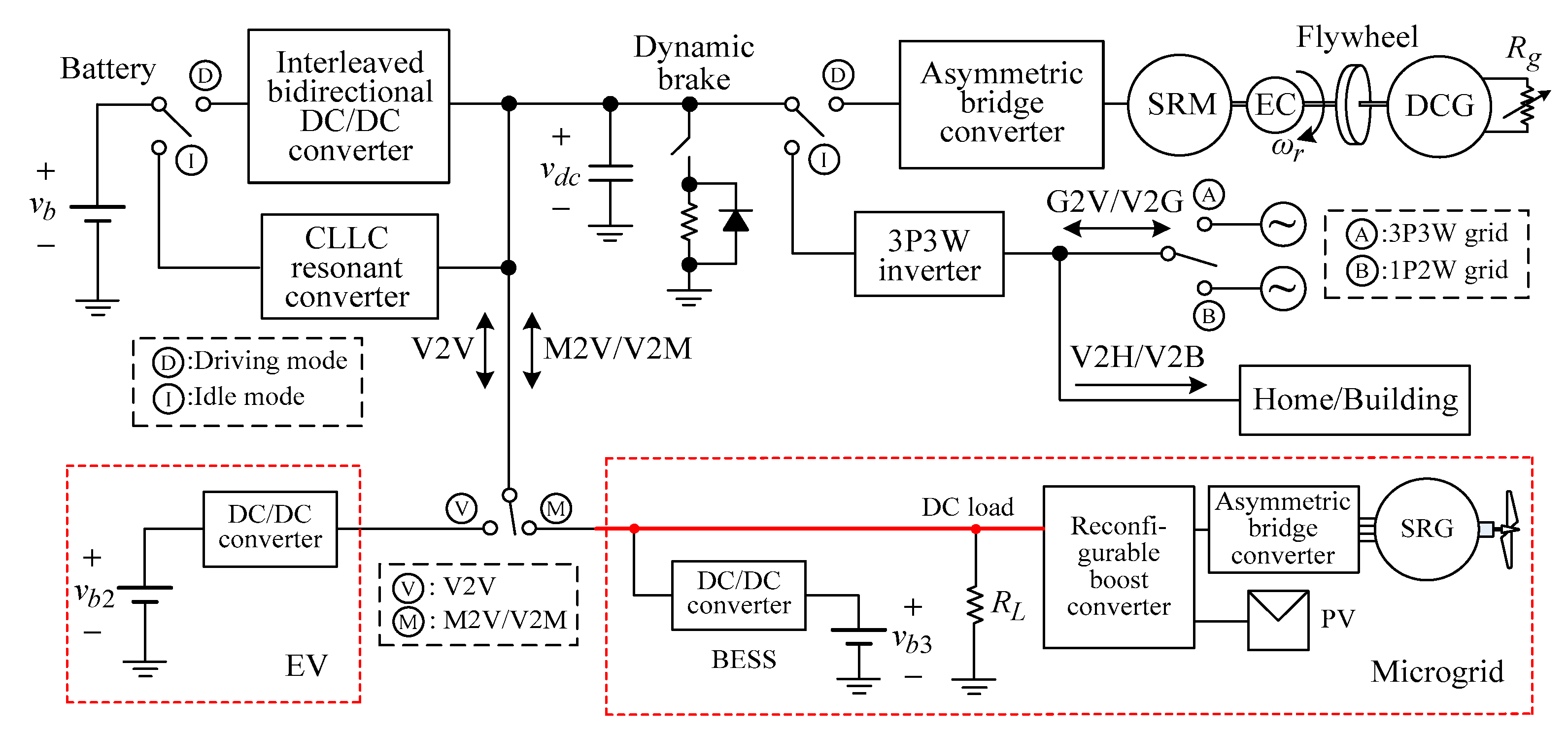
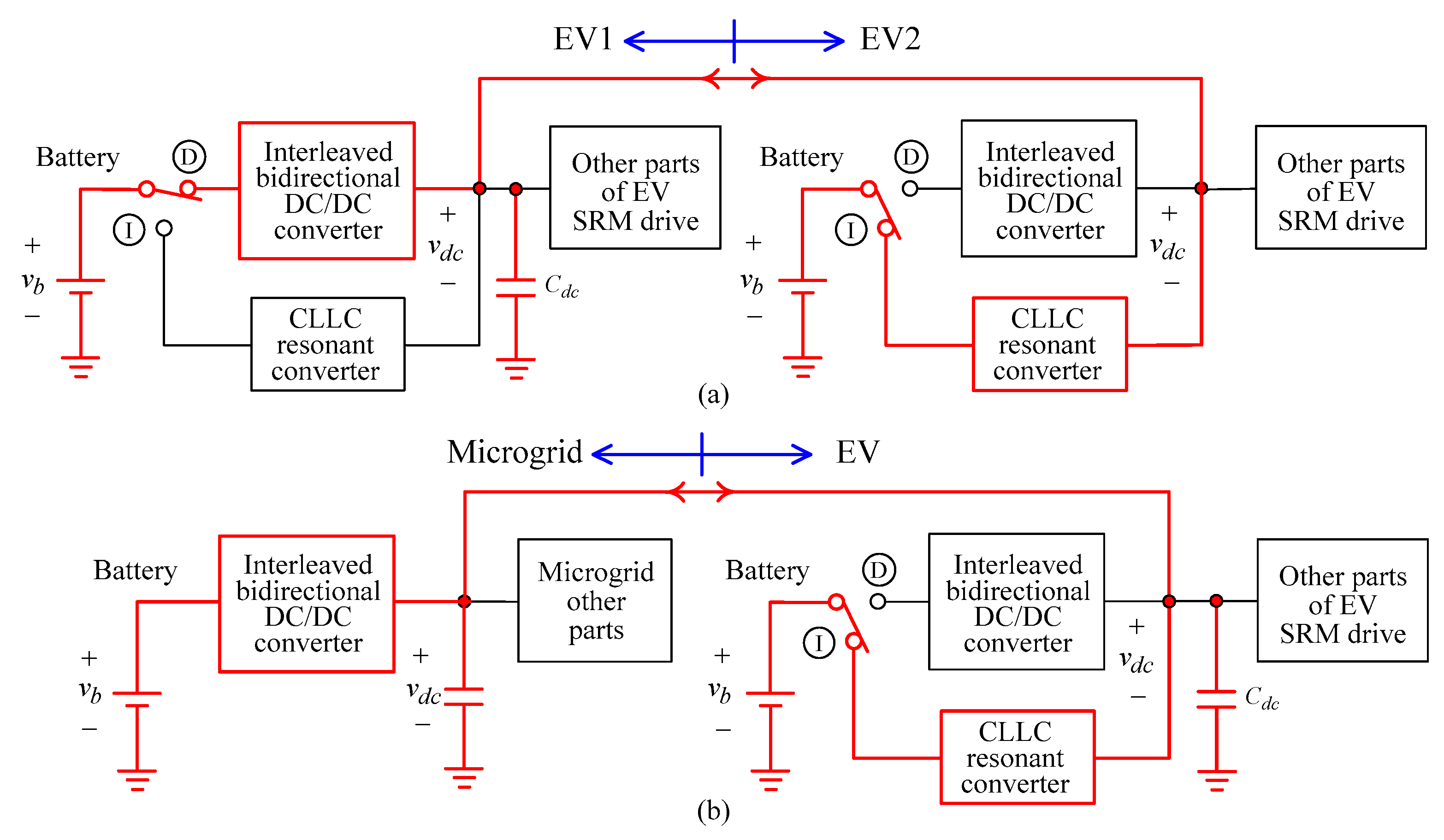
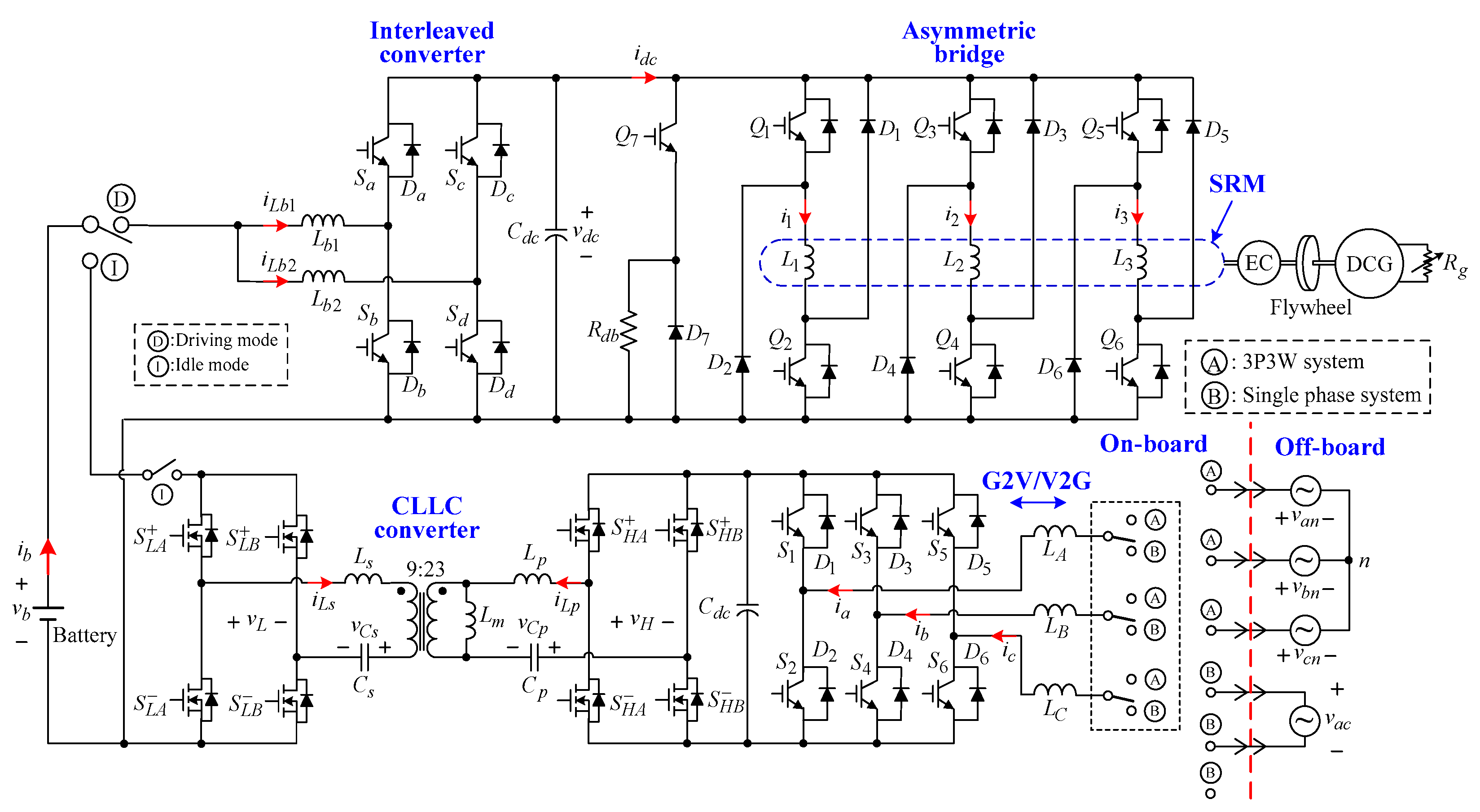
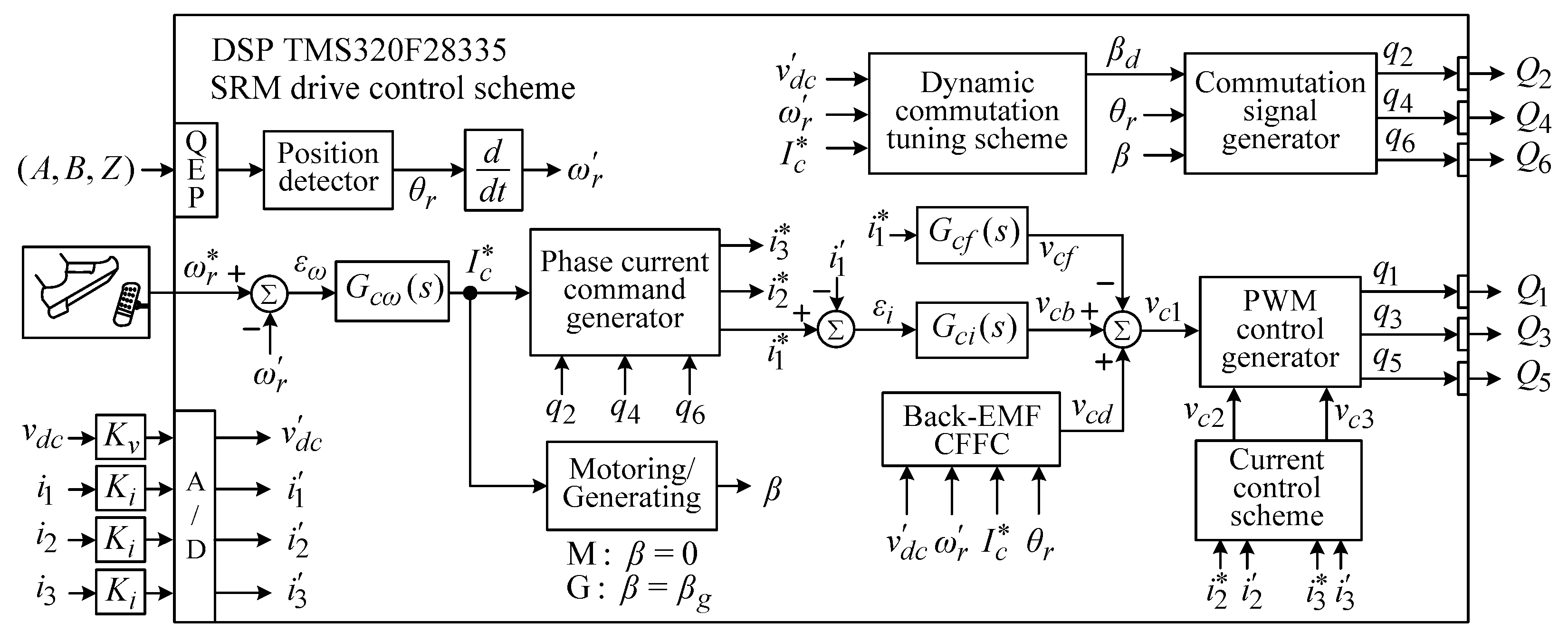


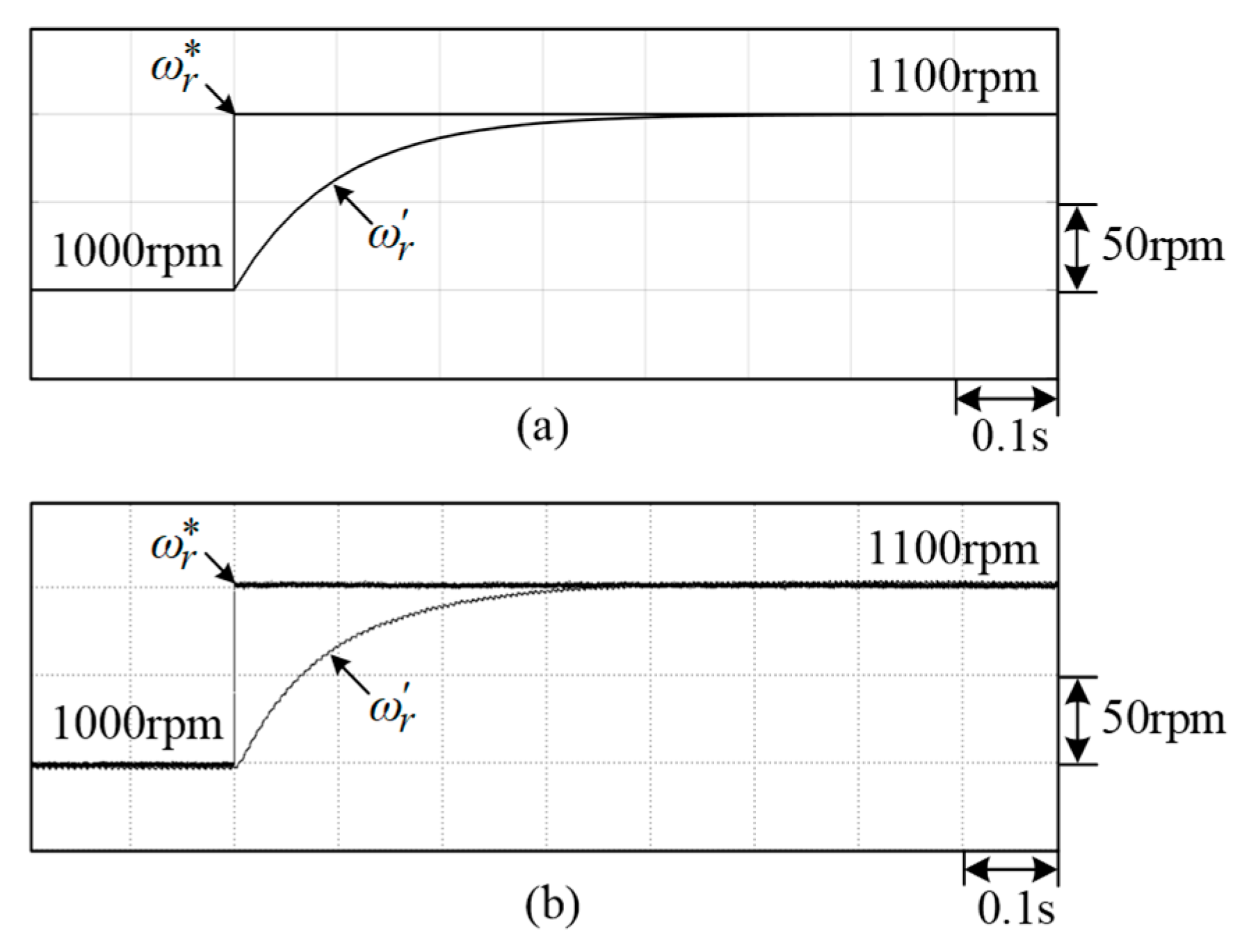

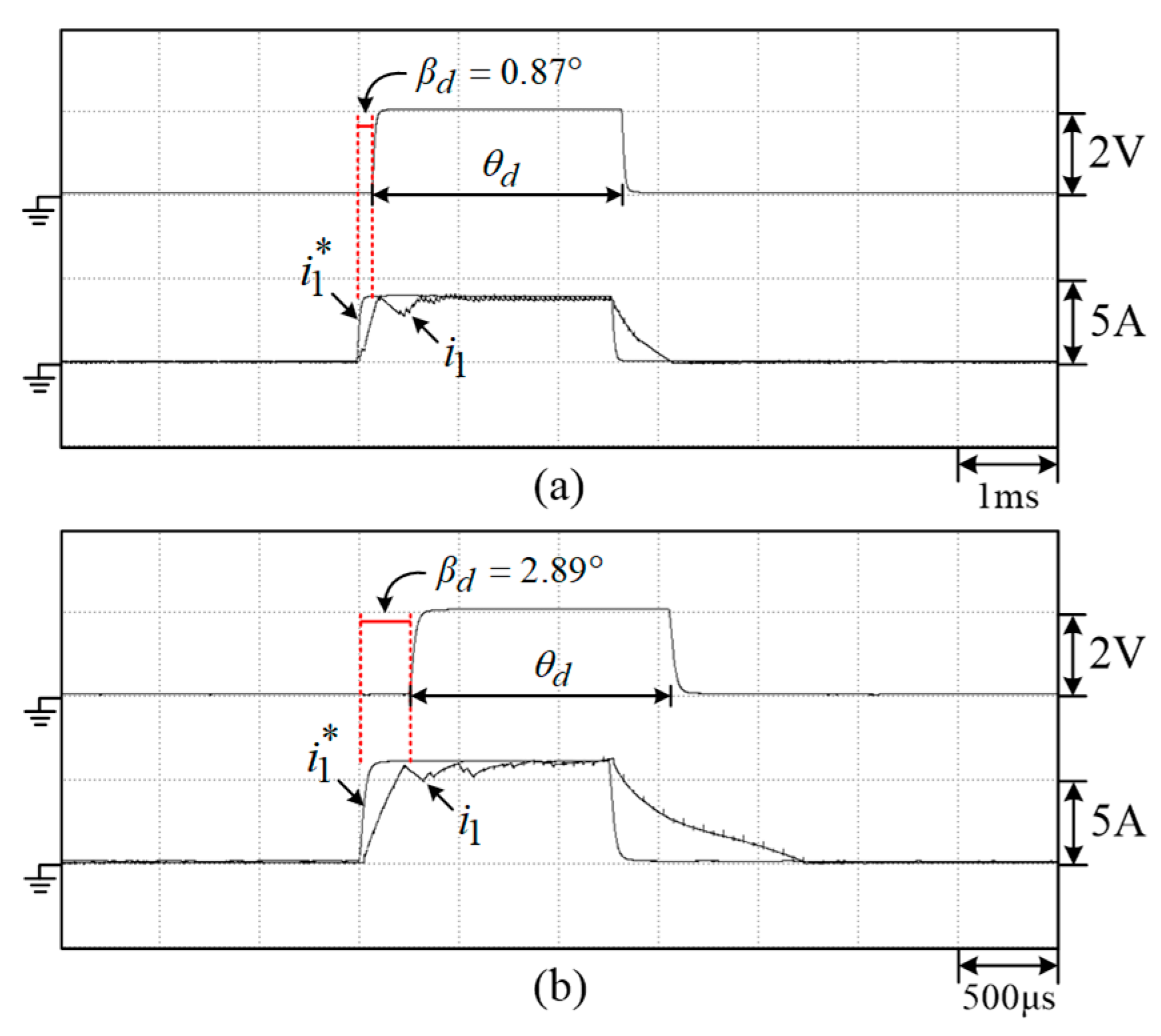
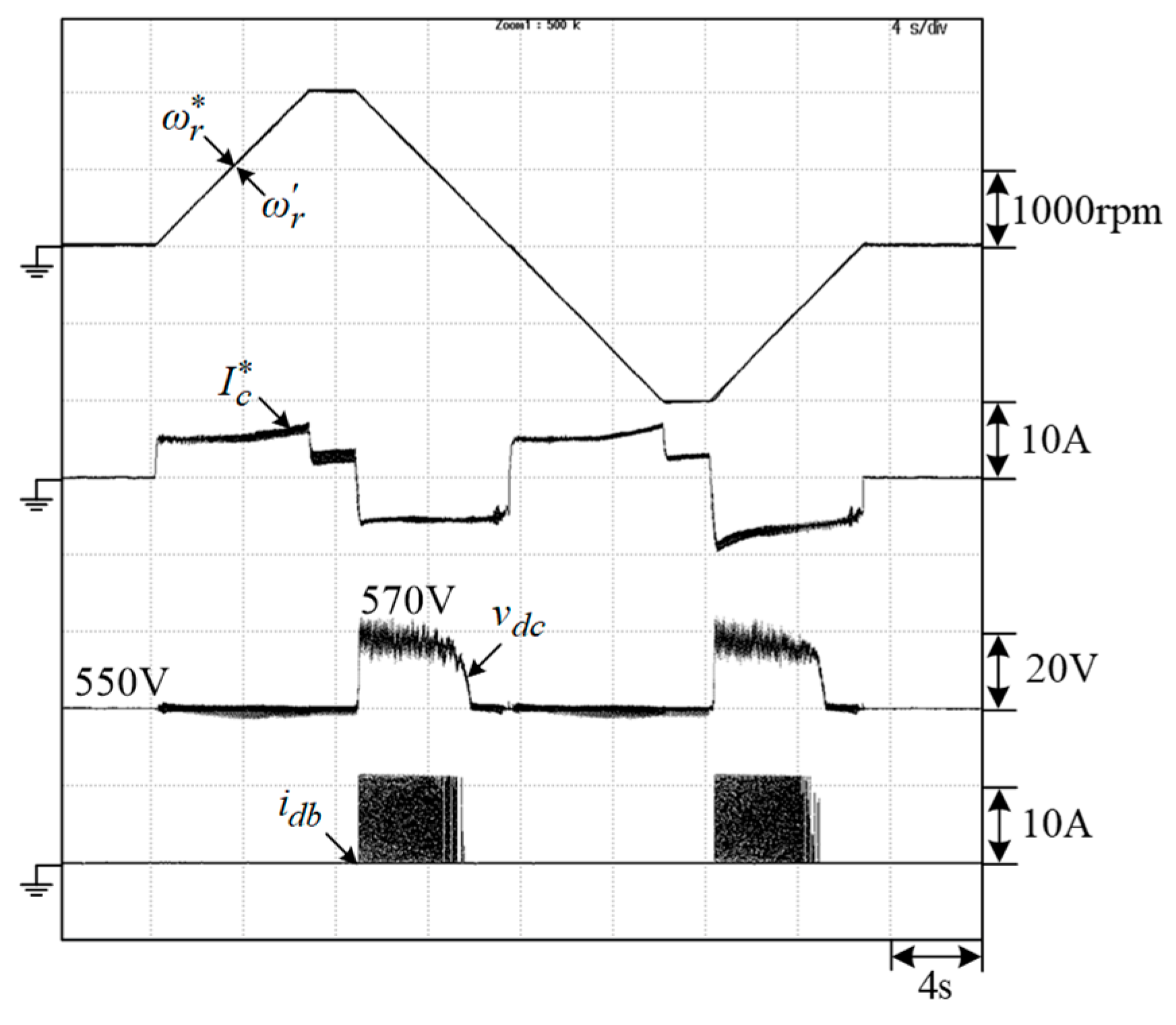
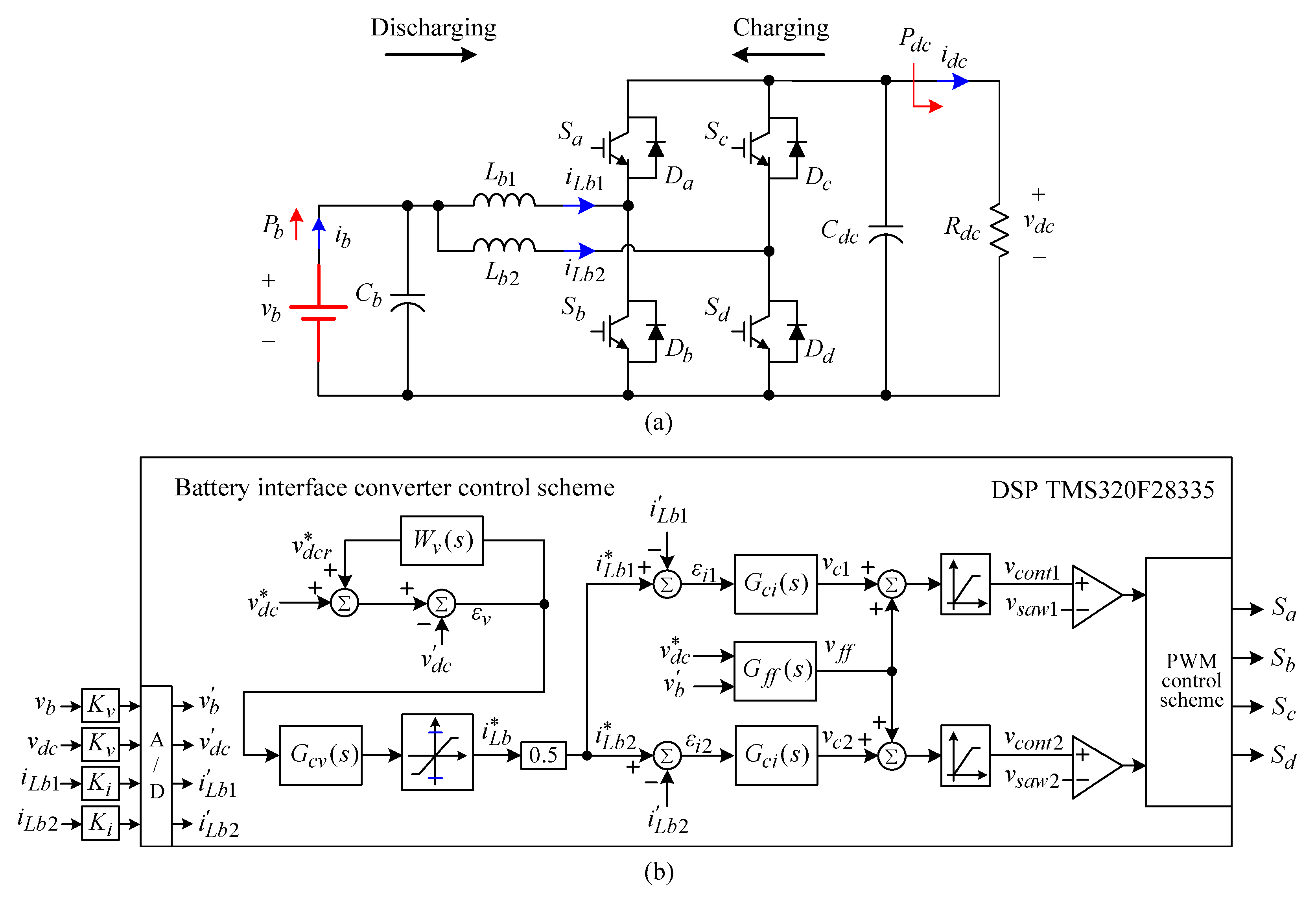





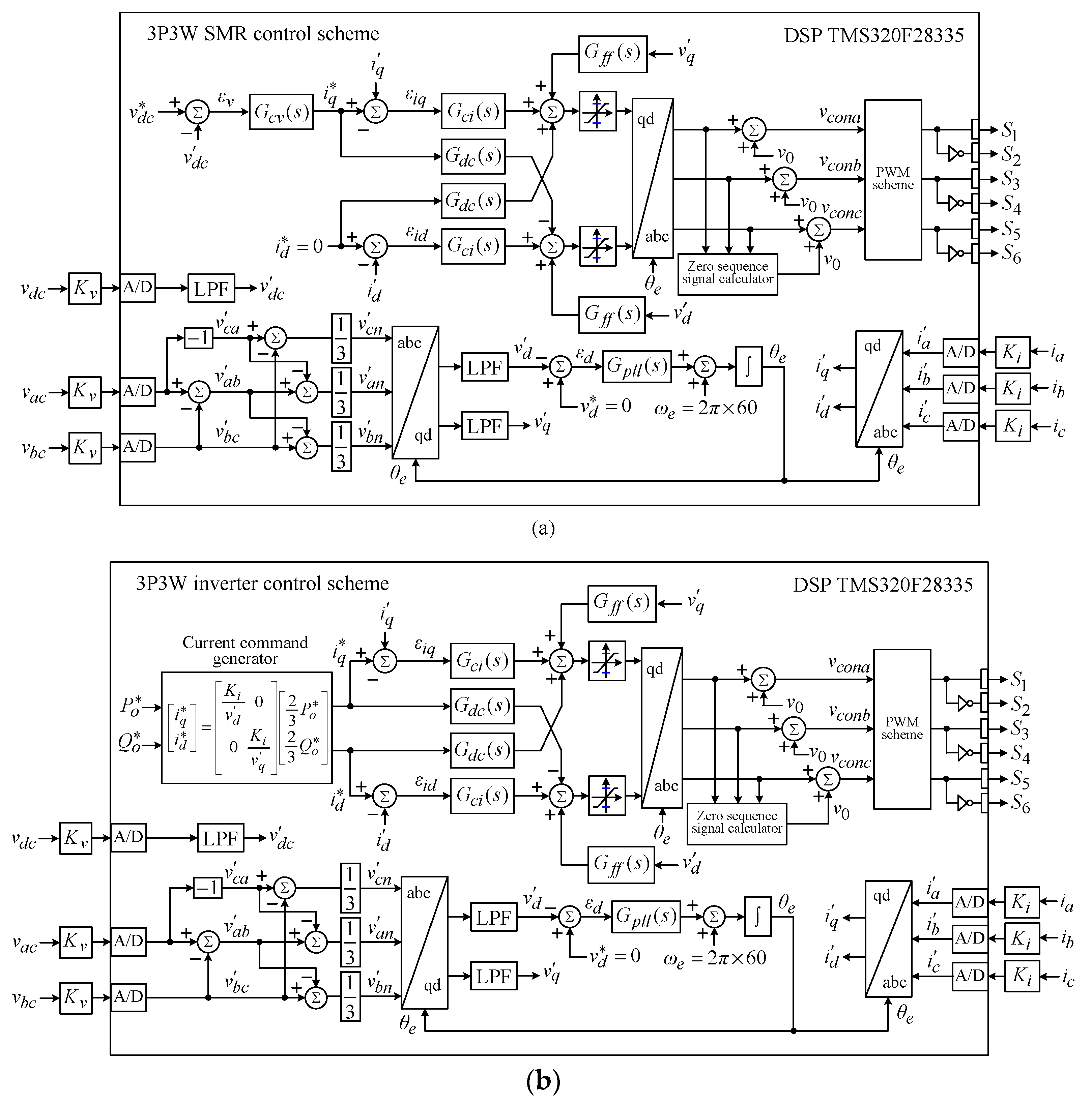

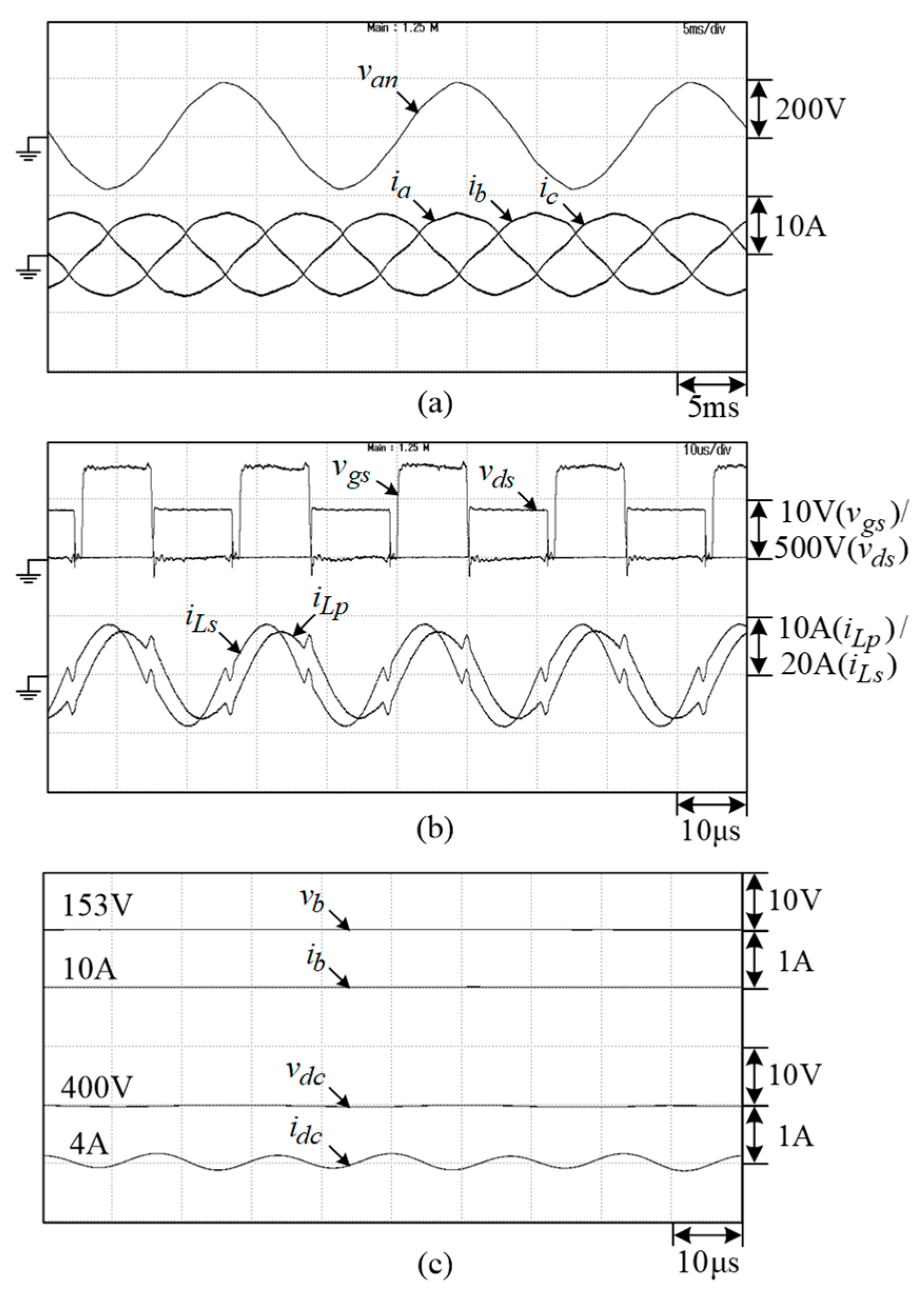

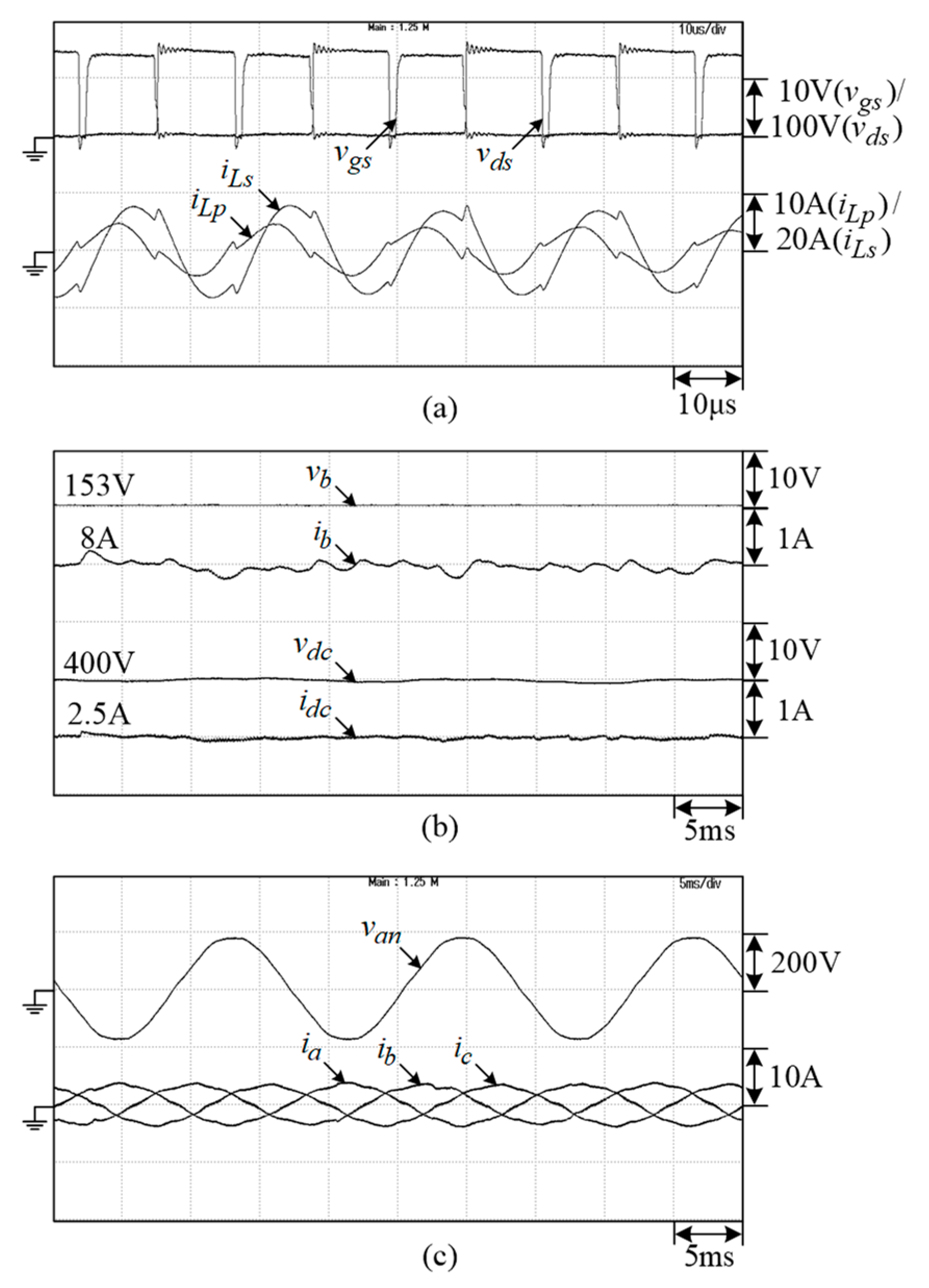
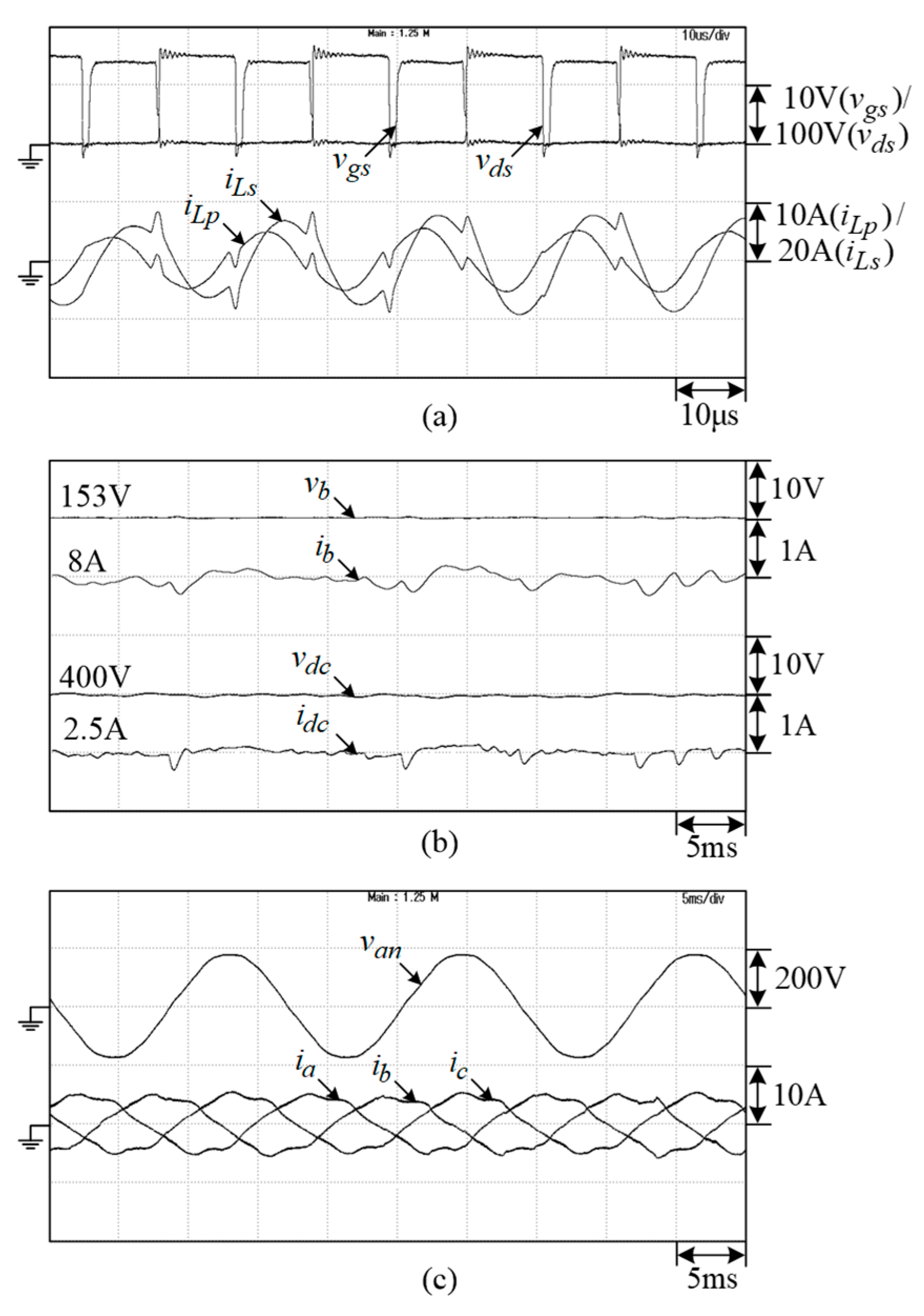

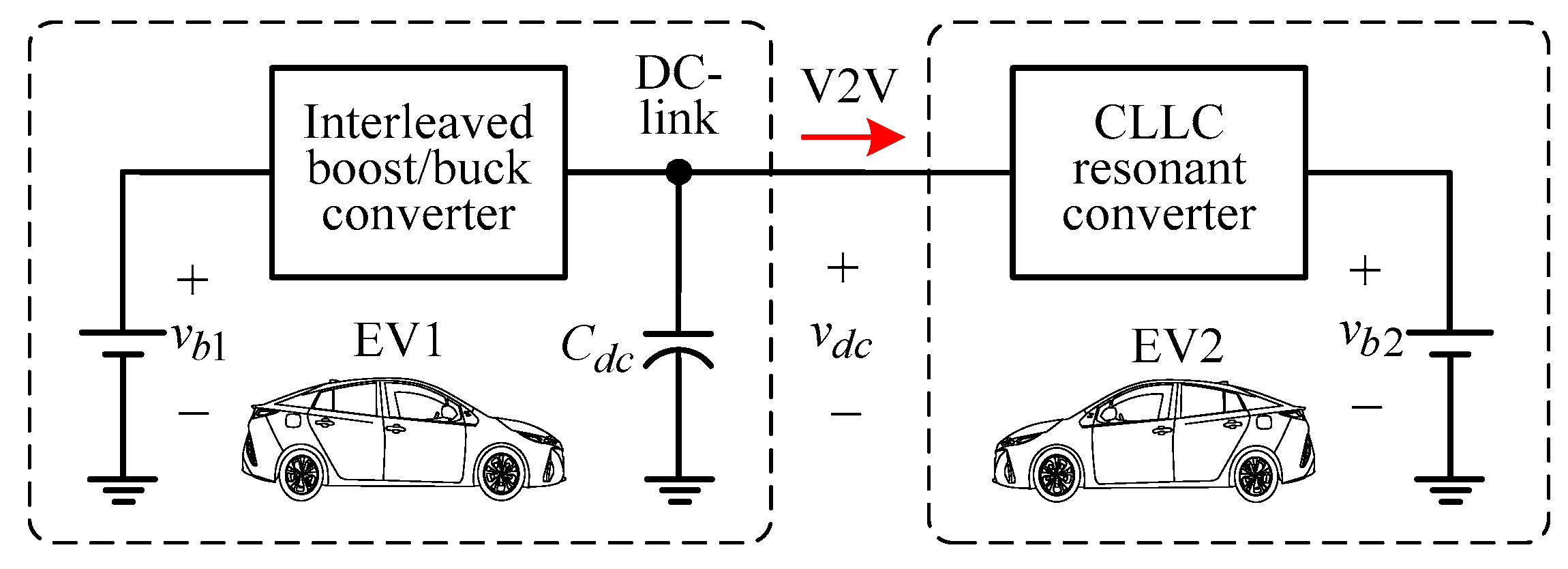


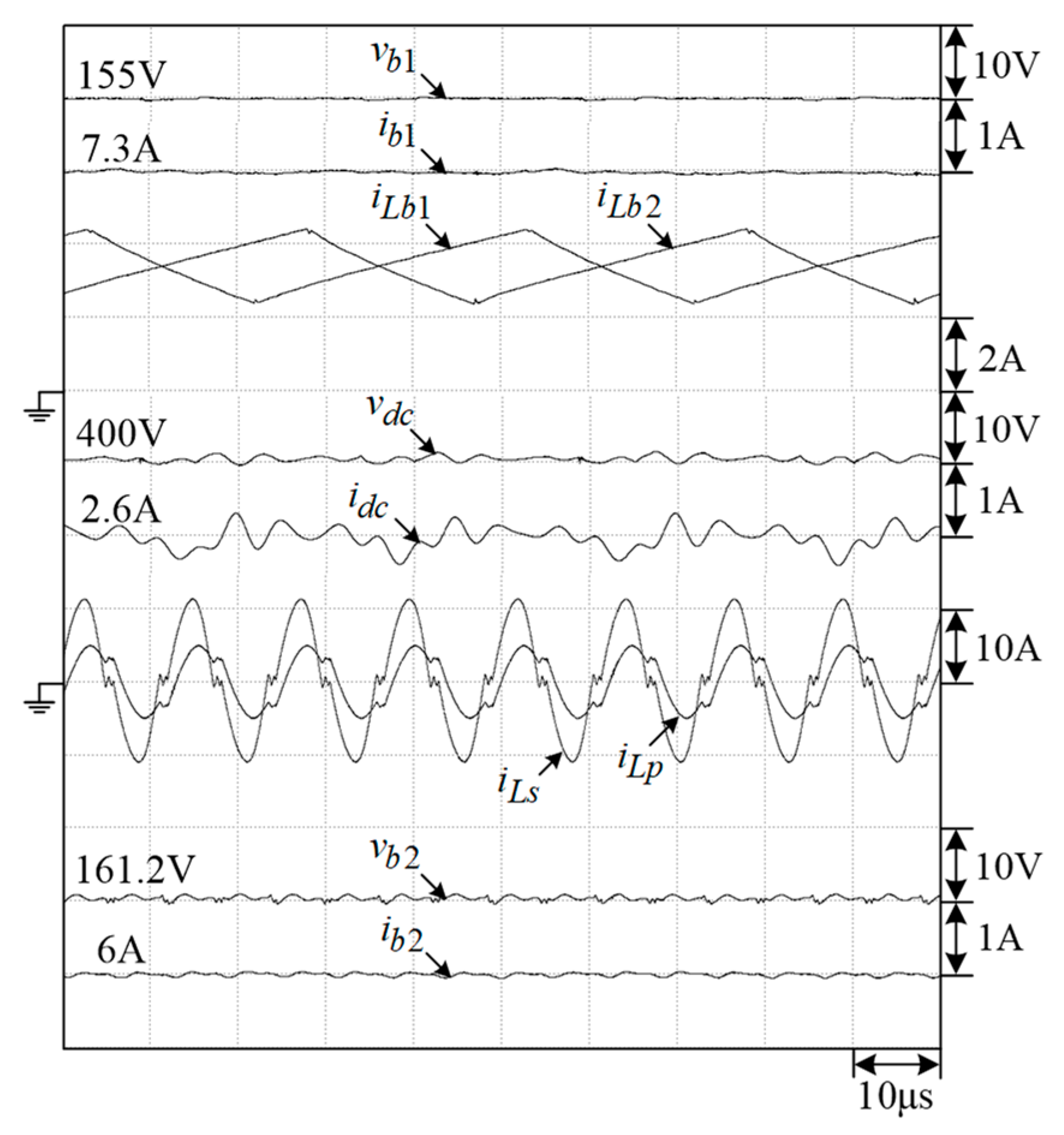
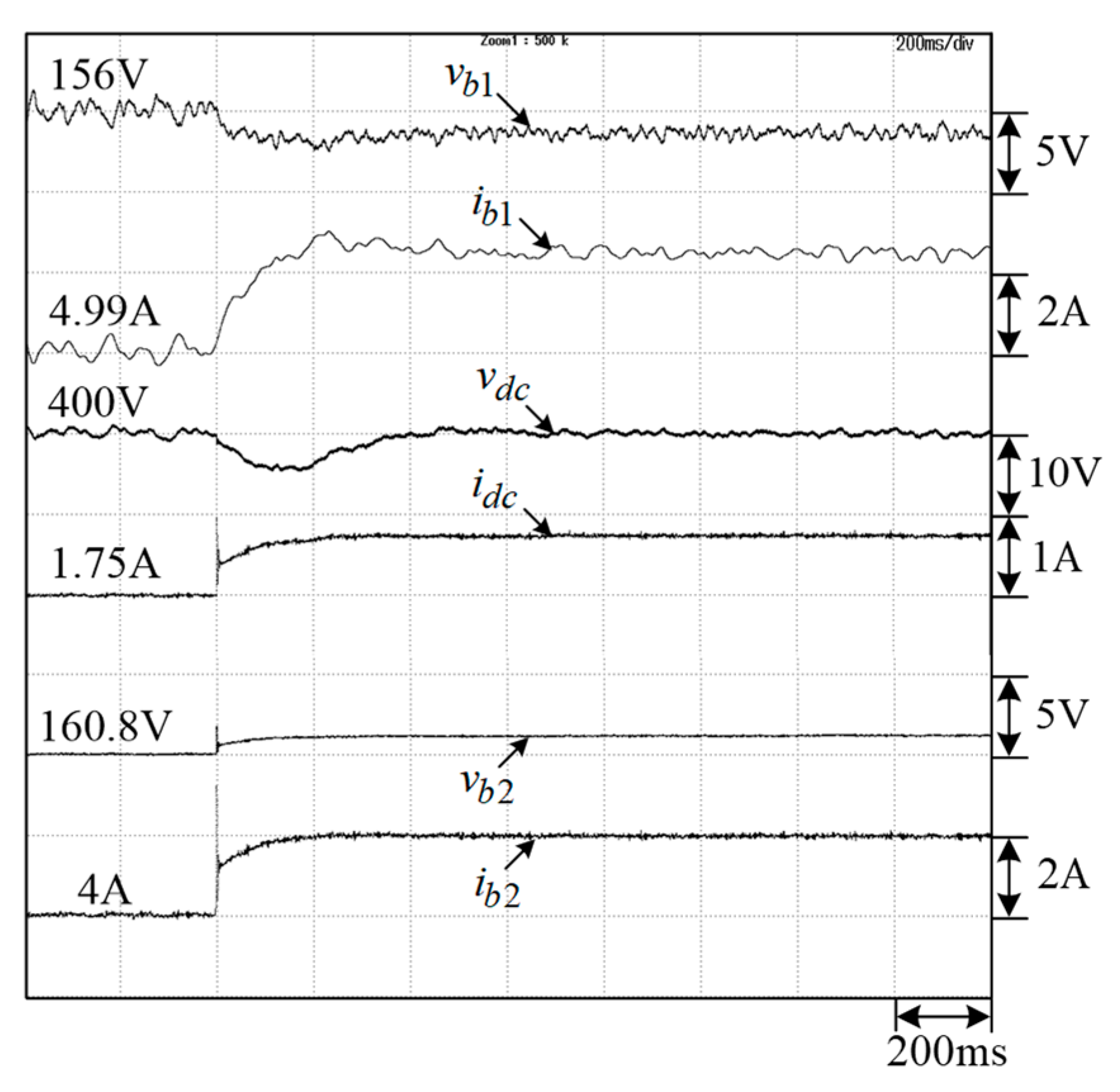
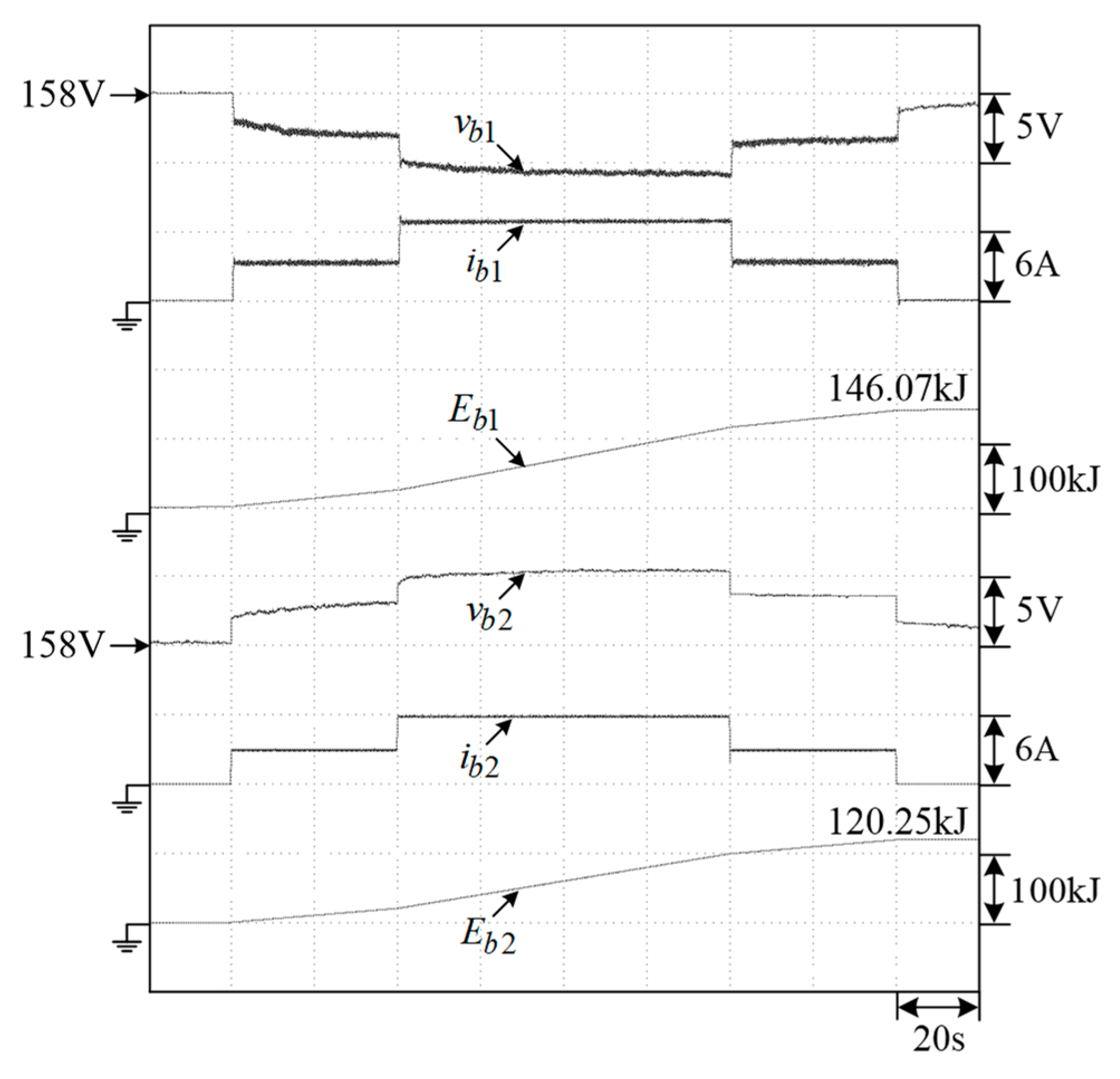
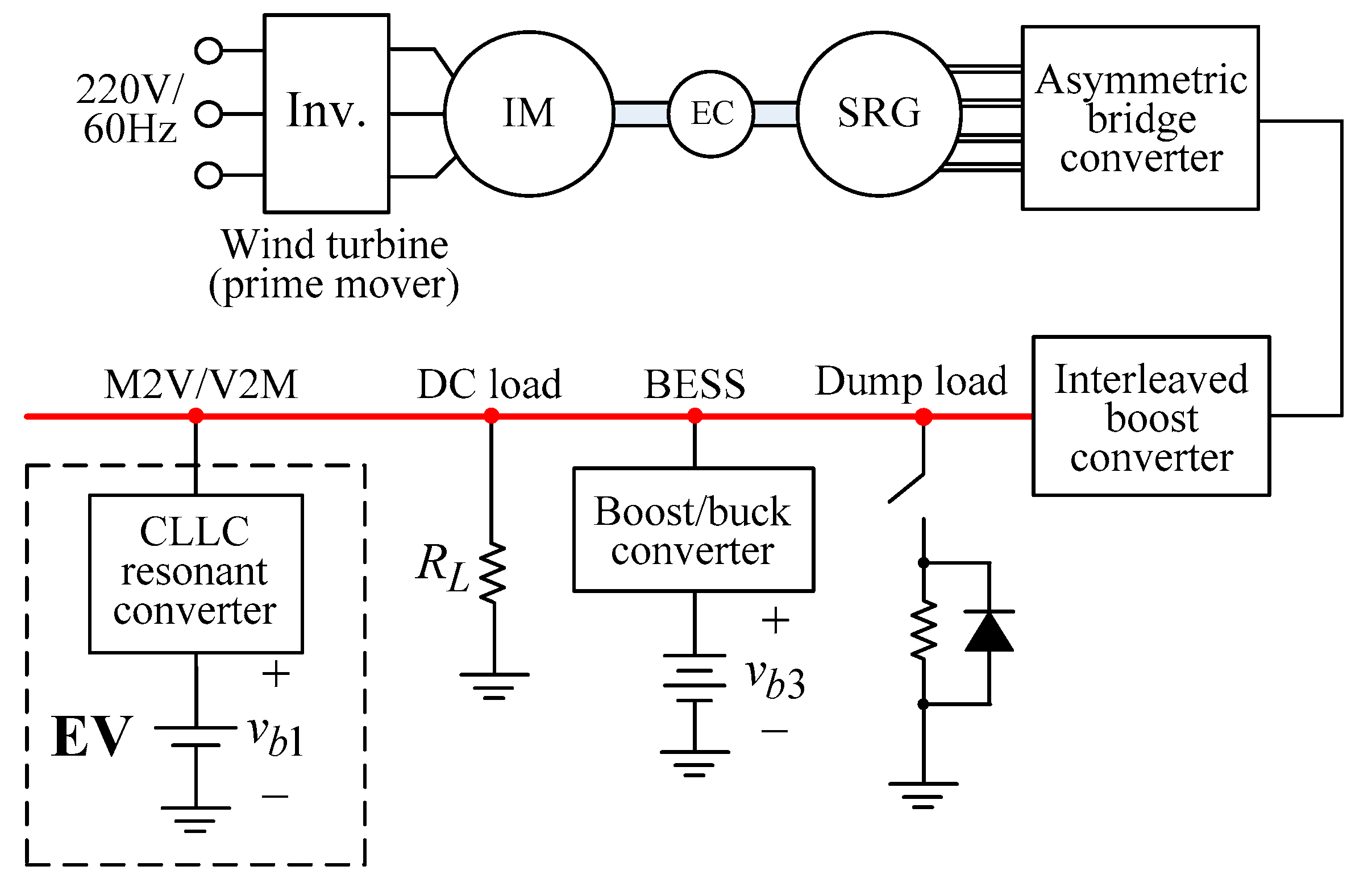

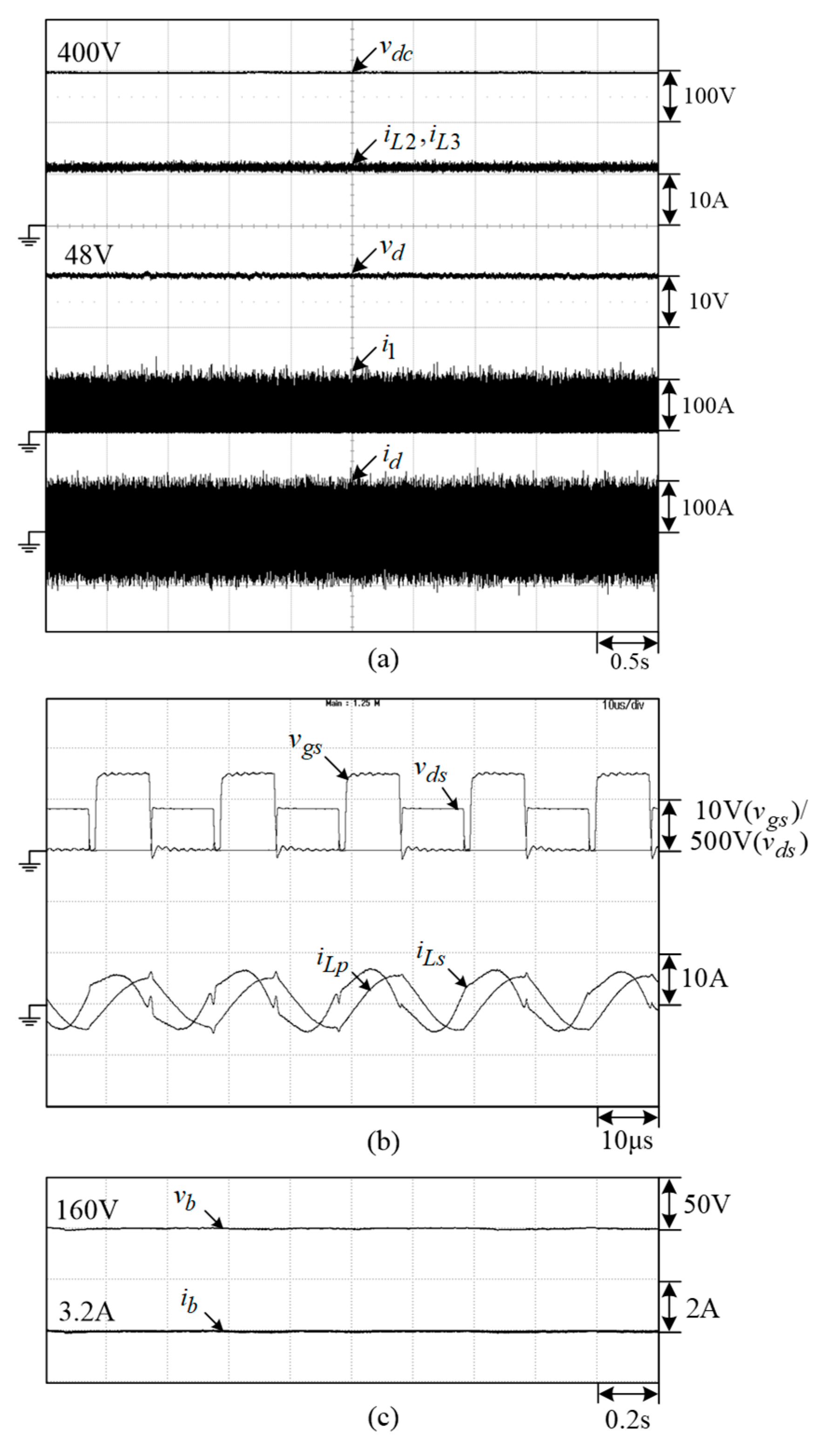
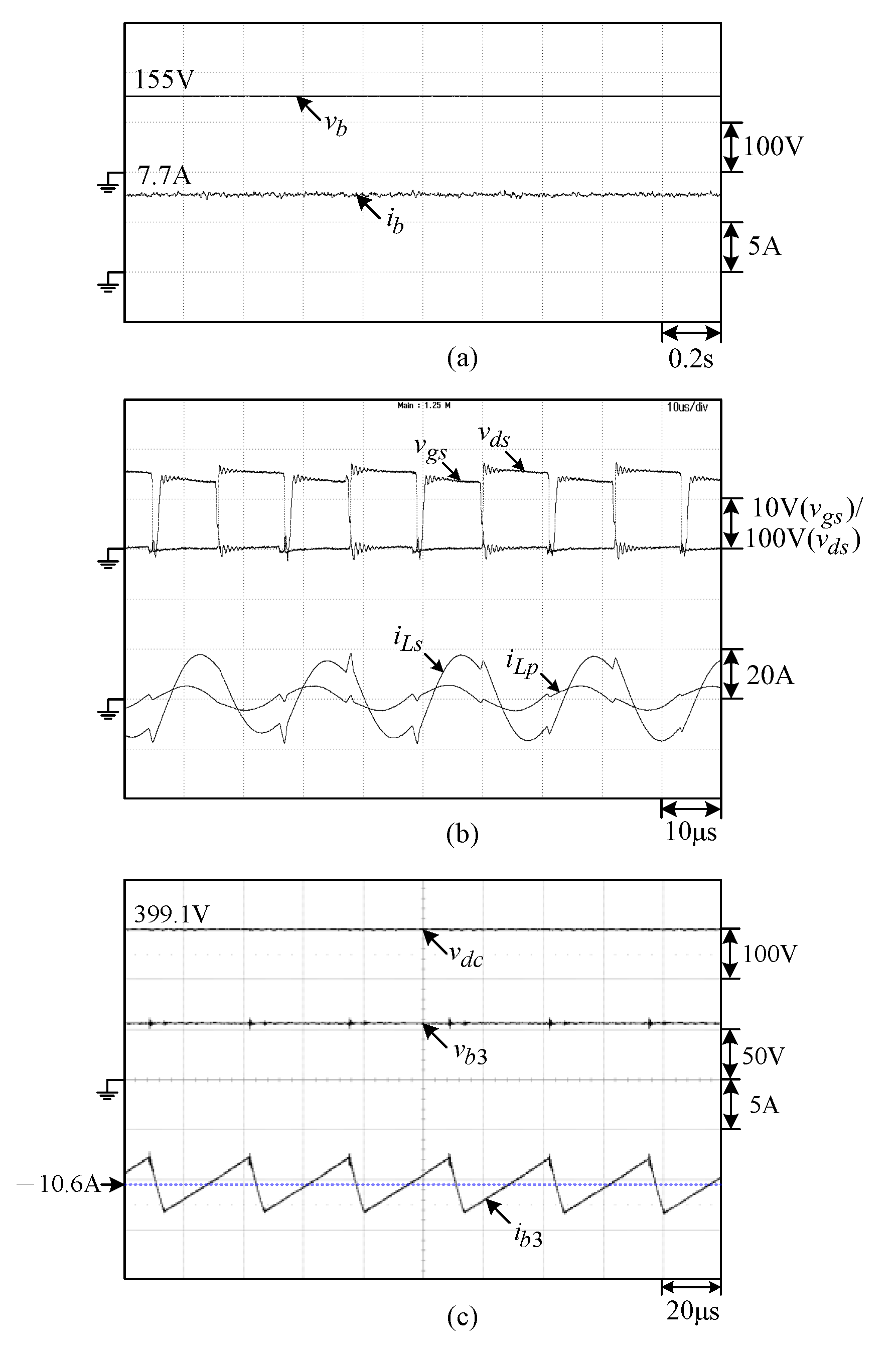
Disclaimer/Publisher’s Note: The statements, opinions and data contained in all publications are solely those of the individual author(s) and contributor(s) and not of MDPI and/or the editor(s). MDPI and/or the editor(s) disclaim responsibility for any injury to people or property resulting from any ideas, methods, instructions or products referred to in the content. |
© 2024 by the authors. Licensee MDPI, Basel, Switzerland. This article is an open access article distributed under the terms and conditions of the Creative Commons Attribution (CC BY) license (https://creativecommons.org/licenses/by/4.0/).
Share and Cite
Gu, W.-K.; Yang, C.-W.; Liaw, C.-M. An EV SRM Drive and Its Interconnected Operations Integrated into Grid, Microgrid, and Vehicle. Appl. Sci. 2024, 14, 3032. https://doi.org/10.3390/app14073032
Gu W-K, Yang C-W, Liaw C-M. An EV SRM Drive and Its Interconnected Operations Integrated into Grid, Microgrid, and Vehicle. Applied Sciences. 2024; 14(7):3032. https://doi.org/10.3390/app14073032
Chicago/Turabian StyleGu, Wei-Kai, Chen-Wei Yang, and Chang-Ming Liaw. 2024. "An EV SRM Drive and Its Interconnected Operations Integrated into Grid, Microgrid, and Vehicle" Applied Sciences 14, no. 7: 3032. https://doi.org/10.3390/app14073032




